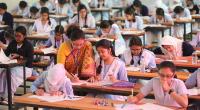 As many as 95 percent of school-going children in the capital are affected by higher nicotine, said an anti-tobacco body.
As many as 95 percent of school-going children in the capital are affected by higher nicotine, said an anti-tobacco body.
"A recent study conducted among school children of Dhaka has found out that 95 percent of school-going children have higher nicotine in their body which is undoubtedly a result of passive smoking," PROGGA, which leads anti-tobacco campaign in Bangladesh, said in a statement issue on Saturday (Jun 1) marking the World No-Tobacco Day.
World No-Tobacco Day was observed in Bangladesh as elsewhere in the world on May 31.
Citing a 2017 Global Adult Tobacco Survey, PROGGA said currently 37.8 million, roughly 35.3 percent of the adult population in Bangladesh use tobacco while 8.1 million people become victim of passive smoking at work on a regular basis.
As many as 48 million adults, mostly women, are exposed to passive smoking at home with another 25 million are exposed at public transport.
The anti-tobacco body, citing a study, said child laborers constitute 50 to 70 percent of Bangladesh' bidi factories’ workforces.
According to WHO, tobacco kills 1 person in every 4 seconds worldwide. It will cause 10 million deaths by 2030 with 70 percent of the deaths will be in developing countries like Bangladesh, reads the statement.
Majority of these deaths will be attributed to lung cancer, Chronic Obstructive Pulmonary Disease (COPD) and tuberculosis.
PROGGA said Public health, in particular the lung health, is in disarray in Bangladesh -- world's 8th largest cigarette market.
According to WHO, cancer accounts 12 percent of deaths in Bangladesh with the majority suffer from lung cancer, said the statement.
12.5 percent of Bangladesh' adult population suffers from Chronic Obstructive Pulmonary Disease while Chronic Respiratory Diseases accounts 28 percent of all tobacco-related diseases and 10 percent of the total deaths.
According to Health Bulletin, published by Directorate of Health, there has been a surge in tuberculosis among children (4.3 percent in 2017 and 2.8 in 2013), said the statement.
As the prevalence of tobacco use in Bangladesh has reached an alarming stage, the anti-tobacco body recommended a set of measures to reduce deaths and illness related to lung and respiratory diseases and to make Bangladesh tobacco-free by 2040.
It's recommendations to impose effective pricing and taxation to bring tobacco items brought beyond the purchasing power of the youth and the poor of the country.
PORGGA suggests to bring the number of price slabs down to two (Tk 50 and Tk 105) from four (Tk 35, 48, 75 & 105) and merge the low and medium tier (Tk 35 and 48 tiers) under a single tier (low) and high and premium tiers (Tk 75 and 105 tiers) under another single tier (high).
It advocates to introduce a 65 percent supplementary duty and a specific tax of Tk 5 per 10 sticks for all cigarettes tiers; eliminate the price distinction between filtered and non-filtered bidis; and set the retail price at Tk 35 per pack of 25 sticks; and impose 45 percent supplementary duty and add a specific tax of T 6.
PORGGA recommended to eliminate the old Tariff Value system in Smokeless Tobacco (Jarda and Gul) and change the tax base to the retail price alike cigarette and bidi; set the retail price of Tk 35 per 10 grams of jarda and Tk 20 for 10 grams of gul; impose the supplementary duty to 45 percent of retail price and add a specific tax of Tk 5 per 10 grams of jarda and Tk 3 per 10 grams of gul.
It also suggests to bring reform to provisions on the ‘Designated Smoking Areas’ among public places in the Smoking and Tobacco Products Usage (Control) Act and ensure Graphic Health Warning printed on tobacco products packs in line with the law.
 Others
Others
40887 hour(s) 33 minute(s) ago ;
Morning 10:27 ; Monday ; Jun 16, 2025
95% Dhaka school-goers affected by nicotine
Send
Bangla Tribune Report
Published : 20:53, Jun 01, 2019 | Updated : 20:58, Jun 01, 2019
Published : 20:53, Jun 01, 2019 | Updated : 20:58, Jun 01, 2019
0 ...0 ...
/si/hb/
Topics: Top Stories
- KOICA donates medical supplies to BSMMU
- 5 more flights to take back British nationals to London
- Covid19: Rajarbagh, Mohammadpur worst affected
- Momen joins UN solidarity song over COVID-19 combat
- Covid-19: OIC to hold special meeting
- WFP begins food distribution in Cox’s Bazar
- WFP begins food distribution in Cox’s Bazar
- 290 return home to Australia
- Third charter flight for US citizens to return home
- Dhaka proposes to postpone D8 Summit
Unauthorized use of news, image, information, etc published by Bangla Tribune is punishable by copyright law. Appropriate legal steps will be taken by the management against any person or body that infringes those laws.
Bangla Tribune is one of the most revered online newspapers in Bangladesh, due to its reputation of neutral coverage and incisive analysis.
F R Tower, 8/C Panthapath, Shukrabad, Dhaka-1207 | Phone: 58151324; 58151326, Fax: 58151329 | Mob: 01730794527, 01730794528


